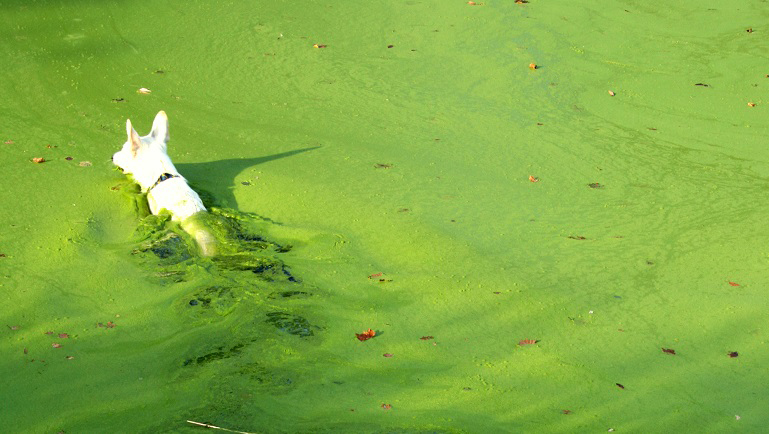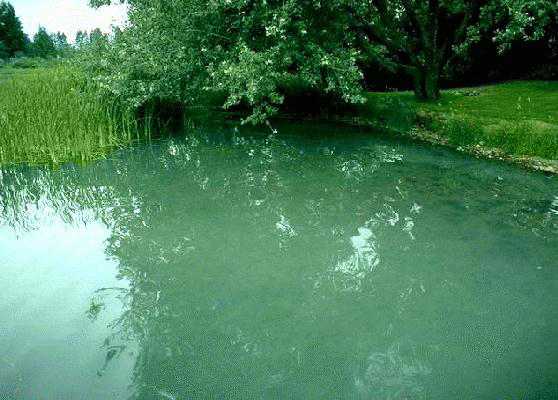
Is the pond in your backyard or park an odd, blue-green color? Does it seem like normal algae, yet smells terrible? Is your dog trying to jump in for a swim?
Stop right there! You might be dealing with blue-green algae, and here are the things you should be aware of.
In this post, learn about the dangers and warning signs of blue-green algae in your pond, water garden, river, lake or waterway. Understand the common causes from overfeeding to fertilizers, along with solutions for algae control related to this particular problem.
What Exactly Is Blue-Green Algae?
In reality, blue-green algae are actually cyanobacteria — not algae. Although it closely resembles common algae, cyanobacteria, or blue-green algae, are completely different organisms. The difference between these two invasive forms is that blue-green algae are very primitive bacteria.
Despite having photosynthesis properties that resemble those found in algae, blue-green algae can potentially be more harmful to an ecosystem and the surrounding environment than its simpler counterpart.
How Is Blue-Green Algae Dangerous for My Pond & Pets?
Although not every case of blue-green algae blooms is toxic, recent studies have shown that these bacteria can be more harmful and lethal to pets than previously thought. Even a small amount can potentially be poisonous, so caution should be used when a cyanobacteria bloom occurs.
It is recommended to always keep an eye on pets and observe their behavior around water to determine if an algae bloom is toxic. Warning signs that a blue-green algae bloom is present include:
- Dead fish or birds inside and around the body of water
- Unexplained sickness or death of pets, such as cats or dogs
- Unpleasant odors emitting from the water
- Skin rashes after recent human contact with the water
Common side effects of cyanobacterial poisoning include:
- Vomiting, diarrhea and jaundice
- Seizures or disorientation
- Coma or shock
- Excessive salivation or shortness of breath
- Death
Considering some of the very dire consequences, it should be your utmost priority to be proactive and learn more about how dangerous toxic algae can be for pets.
How Does Blue-Green Algae Affect My Pond?
Take notice whenever there is a blanket of slime on the surface so you can better recognize how blue-green algae is affecting your pond. Cyanobacteria grow rapidly, so beware of the algae growing thick enough to completely block out sunlight from the water depths, thus harming fish.
This overwhelming bacteria can completely dominate any body of water while prohibiting growth of competing algae. Don’t leave it untreated, or the entire area will quickly be covered by a thick, green layer of bacteria.Blue-green algae blooms are known to appear overnight at any depth of water. For those growing in larger depths, it can be harder to identify, so please proceed with caution if you are a beginner to the pond hobby.
What Can I Do to Prevent Blue-Green Algae?
Prevent blue-green algae blooms in your pond by understanding the causes and knowing how to reduce these fueling forces. Similar to common algae, the main cause for cyanobacteria is excess nutrients in the body of water.

Here are some preventative measures you can take to keep the bloom from occurring:
- Do not overfeed fish or birds, causing an excess of nutrients to accumulate
- Add or maintain native plants around the pond to filter the water
- Properly maintain nearby septic systems, if applicable
- Do not overuse fertilizers for the lawn, garden or plants around the bodies of water
- Do not let pets or livestock defecate in the bodies of water
If you would like to naturally prevent algae in your pond, learn about what plants to add to your pond or water garden for maximum filtering and oxygenating benefits.
How to Protect Your Fish, Pets & Ecosystem!
Identify the algae bloom and make sure to keep animals or children away from the body of water until fully it is diagnosed and removed. Scoop out any debris and start damage control by reporting it to your state department.
Use supplements or additives to balance the pond’s ecosystem while removing the cyanobacteria, much like how the human body uses antibiotics to fight infections. It should be an objective to not use algaecides, as they are dangerous for fish and surrounding wildlife.
Overall, we hope you found this guide to blue-green algae useful in identifying warning signs and eliminating cyanobacteria in your pond. Always use caution when frequenting ponds and lakes with your pets. Remember to report any suspicious algae or bacteria in your local body of water.


